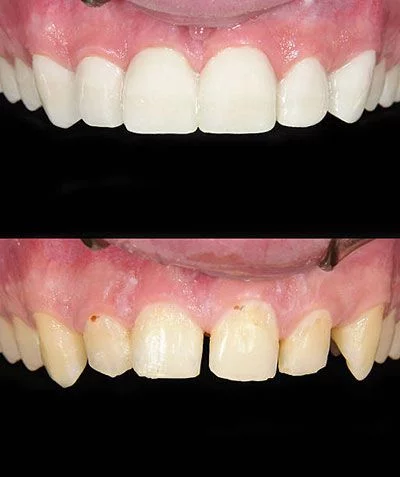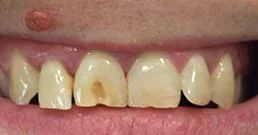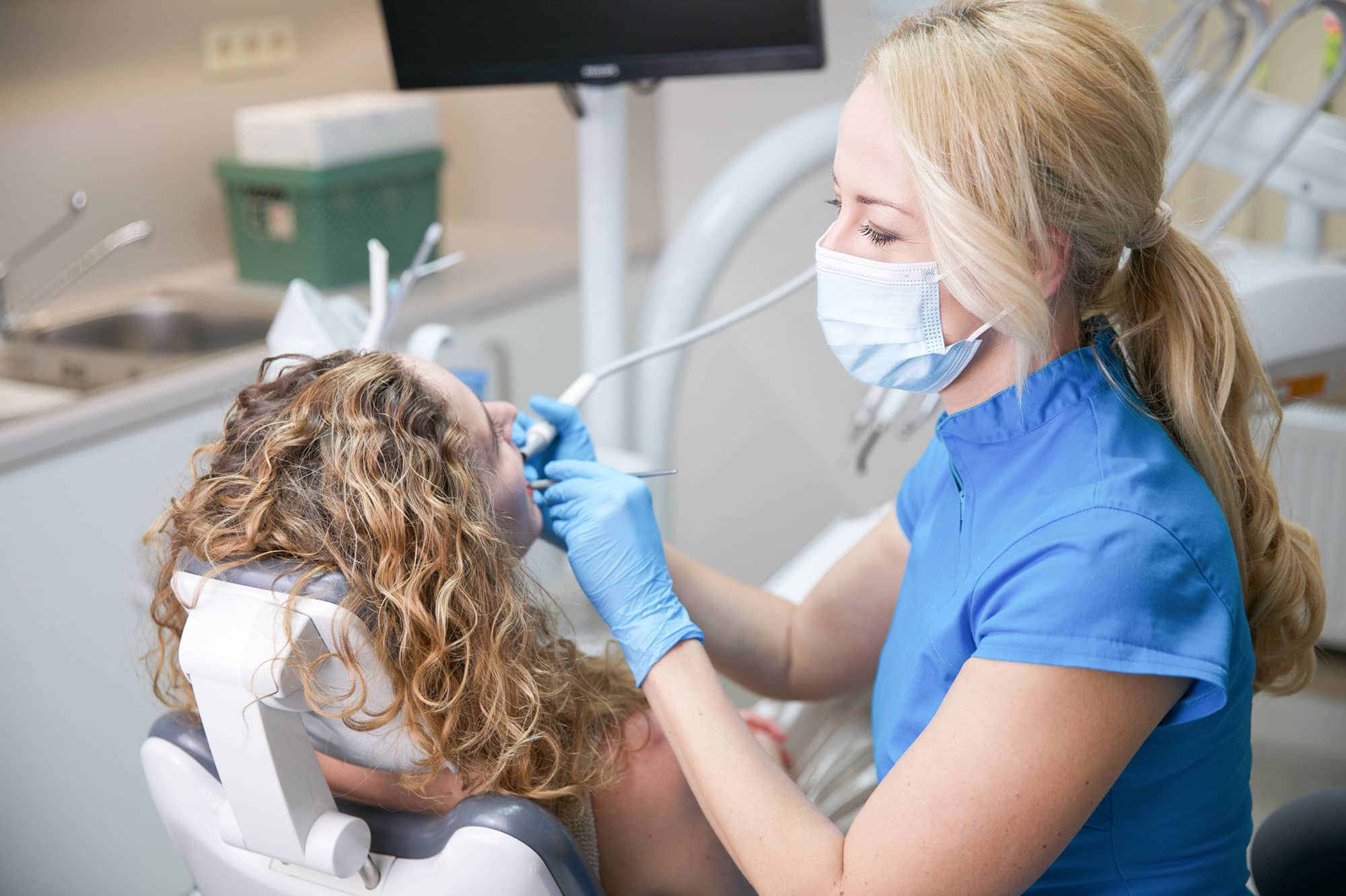The E-max veneers are one of the greatest products in aesthetic dentistry. With the help of contact lens-like ceramics, we can achieve significant changes in a very short time when it comes to colour and size differences or minor defects. The E-max veneers are the secret behind the perfect Hollywood smile.
The main points of our article are the following:

- What are e.max veneers and Emax crowns? Advantages and disadvantages.
- Who are Emax veneers and Emax crowns suitable for?
- Can anyone get Emax veneers, or E-max crowns? Who is not suitable for?
- How long do Emax crowns and Emax veneers last?
- How much do 4, 6, 10, 12 and 20 E-max veneers, Emax crowns cost?
- How veneers are made?
What are E.max Veneers and Emax crowns? Advantages and disadvantages.
E-max veneers and e.max crowns are both dental restorations that are used for aesthetic and functional purposes. While traditional veneers are made of porcelain, the name e.max refers to the lithium-disilicate ceramic material, which provides a strong, durable and natural appearance. Both are very popular in dentistry, especially during aesthetic treatments. E-max veneers are the best quality products among indirect veneers. They are made of durable, quality materials, yet they create a thin layer, making them look natural. E-max veneers are durable, hypoallergenic and metal-free..
What are e.max Veneers?
E.max veneers are thin ceramic layers that are placed on the front surface of the tooth.
Purpose: They are used to improve the appearance of the teeth. They are particularly suitable for changing color, shape or size.
Procedure: The tooth requires minimal preparation. Before the veneers are placed, a small amount of tooth material is removed to allow the veneer to fit smoothly.
Advantages: Natural appearance, thin material that requires less dental material removal.
Disadvantages: Since they only cover the front part of the tooth, they are not suitable for the complete protection of damaged or weakened teeth. They are more fragile and less durable than Emax crowns.
What are e.max crowns?
Emax crowns are tooth replacements that completely cover the tooth, thus providing strong protection and an aesthetic solution.
Purpose: Protection and restoration of weakened, damaged or heavily filled teeth. They are suitable for full dental coverage, so they provide both functional and aesthetic solutions.
Procedure: During tooth preparation, more tooth material is removed so that the crown fits comfortably. The crown is then placed over the entire surface of the tooth.
Advantages: Excellent durability, strong protection, aesthetic appearance. It can restore the full function of the tooth.
Disadvantages: Requires removal of more tooth material than veneers.
Who are Emax veneers and Emax crowns suitable for?
E-max veneers provide a great solution in cases where the patient’s teeth are healthy, but he or she isn’t happy with the appearance of the teeth. Problems with the shape, minor defects or discolouration can make patients feel discontent with their teeth, or maybe tooth whitening wasn’t successful. E-max veneers can provide an effective solution to the following problems.
Enamel defects.
An uneven enamel layer and minor defects of this layer are called enamel defects. The veneer acts as a new, shiny coating layer, hiding these minor flaws.
Minor damages.
 Accidents and minor injuries can cause small cracks in the teeth or on the surface of the teeth, which can affect the whole appearance of your teeth. The individually tailored E-max veneers are excellent for covering these problems.
Accidents and minor injuries can cause small cracks in the teeth or on the surface of the teeth, which can affect the whole appearance of your teeth. The individually tailored E-max veneers are excellent for covering these problems.
Cracked, chipped teeth.
During eating, small damages and cracks can occur on the chewing surface of the tooth. For example, when eating different nuts, opening the harder shells with the tooth can, in many cases, cause serious damage to the biting edge of the tooth.
Discolouration of the teeth.
Tooth discolouration is very common. The reasons are discussed in detail below. Discolouration after root canal treatment, Lifestyle: coffee and tea, poor oral hygiene, smoking, Discolouration caused by medications, Genetics. If internal or external tooth bleaching doesn’t help with this problem, E-max veneers can bring you the desired results.
Minimal lengthening of small or short teeth.
Since E-max veneers provide excellent coverage of the surface of the teeth, they help to reduce or eliminate minor differences in the size of the teeth. Thus, the appearance of the teeth becomes more uniform, and harmonious.
Can anyone get Emax veneers, E-max crowns? Who are not suitable for?
As already mentioned, veneers are an excellent tool for correcting minor defects. E-max veneers are perfect for fine-tuning. In the following cases though, instead of E-max veneers, other dental solutions are needed.
Badly damages teeth.
 E-max veneers are not suitable for repairing badly damaged teeth. These problems are discussed below. dental crowding, bite problems, major damage to the front tooth that also affects chewing, large fillings, inflamed gums, larger gaps between teeth, major aesthetic problems.
E-max veneers are not suitable for repairing badly damaged teeth. These problems are discussed below. dental crowding, bite problems, major damage to the front tooth that also affects chewing, large fillings, inflamed gums, larger gaps between teeth, major aesthetic problems.
Lifestyle, hygiene.
E-max veneers are not recommended if the patient’s lifestyle prevents or rules out using them. poor oral hygiene, teeth grinding at night, use of mouth guards for sports, use of wind musical instruments.
We emphasize that this list is not complete. The preparation for a successful E-max veneer fitting always requires consultation beforehand.
Are Emax veneers and Emax crowns healthy for the teeth?
If Emax Venners or E-max crowns are placed, grinding is necessary, so the structure of the tooth is broken, which results in the loss of intact tooth material. If you have already been fitted with Emax Veneers or an E-max crown, you must wear them from now on. If you choose the more expensive non prep Veneers (Lumineers), the integrity of the tooth can be saved, but due to the strength of the glue, this is not guaranteed either.
How long do Emax crowns and Emax veneers last?
The average lifespan of Emaxes is 10-15 years, but with proper care they can last even longer. In the case of veneers, the lifespan also depends on how well the patient takes care of them, as they only cover the surface of the tooth, so they are more fragile and less load-bearing than crowns.
What happens to Emax veneers after 10 years?
Emax Veneers and Emax crowns also need to be replaced when they wear out, but this is often more than 10 years. With proper dental care, this time can be significantly extended.
The secret to the longevity of E-max teeth.
E-max veneers will last years. Unlike direct veneers, indirect veneers have a lifespan of up to a decade. Of course, as with any dental procedures, oral hygiene, care, and lifestyle are extremely important in terms of durability. In this chapter, we will talk about aftercare.
Cleaning E-max veneers.
For cleaning E-max veneers, we recommend using extra-soft toothbrushes and enamel-friendly toothpaste. It is also extremely important to clean the spaces between the teeth when brushing your teeth. Since E-max veneers don’t cover the back of the tooth, poor oral hygiene is a risk factor in the development of dental caries. Therefore, in addition to interdental spaces, you should take special care in this area as well.
Since E-max veneers don’t cover the back of the tooth, poor oral hygiene is a risk factor in the development of dental caries. Therefore, in addition to interdental spaces, you should take special care in this area as well.
Prevention of gingivitis.
Inflammations don’t favour the aesthetic characteristics of E-max veneers, as the cementation joints become visible when the gums retract. If the shape of the gums changes as a result of inflammation, it may be necessary to make new veneers.
Avoiding bad habits.
The thin shells of E max veneers are vulnerable, so its wearers are strongly recommended to avoid some bad habits. These include nail-biting, chewing the tip of a pencil, breaking the strong shell of nuts with our teeth, etc. The veneers are sensitive to heat or sudden temperature changes. It is therefore advisable to avoid consuming food and drinks that are too hot or too cold.
Since the damaged indirect veneers can’t be repaired, the only solution is to make another set of veneers.
How much do 4, 6, 10, 12 and 20 Emax Veneers,or E-max Tooth on the teeth cost?
Due to excellent dental laboratories and market competition, the benefits offered by E-max veneers are now available to everyone. The price of E-max veneers, the professional work involved in making them and the benefits are perfectly in line now. If you want the finest solution for your dental problems, consult your dentist and select the custom treatment plan that suits you best.
| What is the cost of e-max Veneers, Emax Tooth? | USA | In abroad – Hungary | ||||
|---|---|---|---|---|---|---|
| All prices are indicated in British Pounds | Average prices | BestDentalSolutions | You save | |||
| e-max Veneers, Emax Tooth cost 4 pieces | USA –3 960 $ | Hungary –1 600 $ | You save –2 360 $ | |||
| e-max Veneers, Emax Tooth cost 6 pieces | USA –5 940 $ | Hungary –2 400 $ | You save –3 540 $ | |||
| e-max Veneers, Emax Tooth cost 10 pieces | USA –9 900 $ | Hungary –4 000 $ | You save –5 900 $ | |||
| e-max Veneers, Emax Tooth cost 12 pieces | USA –11 880 $ | Hungary –4 800 $ | You save –7 080 $ | |||
| e-max Veneers, Emax Tooth cost 20 pieces | USA –19 800 $ | Hungary –8 000 $ | You save –11 800 $ | |||
| I want to get a quote | ||||||
Are 4, 6, 10 Emax Veneers, E-max Tooth enough?
Fixing 4 Emax Veneers, E-max Tooth is not aesthetic. Rarely 6, usually 8 Emax Veneers, E-max Tooth are enough for an average mouth per row of teeth, 10 for a wider mouth.
How many Emax Veneers, E-max Tooth do you need for a full smile?
The perfect smile can be achieved with 20 Emax Veneers, E-max Tooth (10 at the bottom and 10 at the top), as they completely cover the smile line.
Treatment with veneers does not contribute to aesthetics, as the contour recedes or is disproportionate. In such cases, gingivoplasty is always necessary first. This is how we achieve an aesthetically pleasing result.
How veneers are made?
Unlike direct venners, E-max veneers require some time to make. However, the result is worth the preparation and effort. Thanks to the excellent dentist’s offices and laboratories, the process of making the veneers can be completed in a week.
Consultation.
As part of the consultation, the specialist will assess the condition of your teeth and you will discuss what dental solutions are best for your problems.
The treatment plan, smile planning
As part of the first consultation or as part of the next consultation a detailed plan will be drawn up. If required, a digital previsualisation of your teeth can be created using smile design software.
One of the most important parts of design is colour design. The key to choosing the right colour is to make sure the colour of the finished veneers is perfect for your features.
Diagnostic cast.
Diagnostic casts are made in the first appointment after minimal preparation (polishing) of the teeth. The preparation and diagnostic cast are painless procedures, but local anaesthesia is perfect for these minor inconveniences.
At the end of the treatment, temporary veneers can be placed on the teeth if necessary. So you don’t have to be ashamed of your teeth while your veneers are being made.
Laboratory work.
The dental laboratory will create your custom venners with the help of diagnostic casts. This process usually takes 3-4 days.
Veneer cementation.
Your dentist will place the veneer on your tooth and examine its fit. If you like it, your doctor will cement it to your tooth. During the cementation of E max veneers you might feel mild discomfort or temporary sensitivity may occur. However, with local anaesthesia, this can easily be eliminated.
Read Veneers before and after experiences from our patients and get to know our dental clinics.

